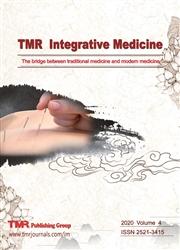Ercao Qinggan decoction regulates apoptosis of hepatocytes in mice with acute liver failure via the TLR4-mediated PI3K/Akt/GSK3β signal pathway
引用次数: 1
Abstract
Background: To clarify the inhibitory effect of Ercao Qinggan decoction (EQD) on acute liver failure (ALF) and its related mechanisms. Methods: HL-7702 hepatocytes were pretreated with TLR4 inhibitor CLI-095, glycogen synthase kinase 3 β (GSK3 β) inhibitor LiCl and different doses of EQD for 2 hours, and lipopolysaccharide (LPS) (10 μg/mL) for 24 hours. Cell apoptosis, TNF-α and IL-6 and GSK3β were detected by flow cytometry, immunofluorescence, quantitative polymerase chain reaction. After mice were gavaged with different concentrations of EQD for 12 days, ALF mouse models were established intraperitoneal injection of D-Gal/LPS. After 24 hours, the mice were euthanized and the liver tissue was stained with hematoxylin and eosin. Liver cell apoptosis, the serum levels of aspartate aminotransferase, alanine aminotransferase, TNF-α and IL-β were detected by terminal transferase-mediated dUTP nick end-labelling, enzyme linked immunosorbent assay, quantitative polymerase chain reaction, and Western blotting, respectively. These methods were also used to test the mRNA expression of Bax, Bcl-2 and the protein expression of GSK3β, p-Akt/Akt in livers. Results: CLI-095, LiCl, and EQD significantly inhibited apoptosis induced by LPS, the mRNA expression of IL-6, TNF-α and the nuclear translocation of GSK3β in HL-7702 hepatocytes. EQD dose-dependently inhibited hepatocyte apoptosis, the serum concentration of aspartate aminotransferase and ALT, the expression of TNF-α and IL-β, the ratio of p-GSK3β/GSK3β, p-Akt/Akt in alanine aminotransferase mice. Conclusion: EQD can inhibit hepatocyte apoptosis in ALF mice through regulating TLR4/PI3K/Akt/GSK3β signaling pathway.二草清肝汤通过tlr4介导的PI3K/Akt/GSK3β信号通路调控急性肝衰竭小鼠肝细胞凋亡
背景:探讨二草清肝汤对急性肝衰竭(ALF)的抑制作用及其机制。方法:用TLR4抑制剂cl -095、糖原合酶激酶3 β (GSK3 β)抑制剂LiCl和不同剂量的EQD预处理HL-7702肝细胞2 h,脂多糖(LPS) (10 μg/mL)预处理24 h。采用流式细胞术、免疫荧光、定量聚合酶链反应检测细胞凋亡、TNF-α、IL-6、GSK3β。小鼠灌胃不同浓度EQD 12 d后,腹腔注射D-Gal/LPS建立ALF小鼠模型。24小时后,将小鼠安乐死,并用苏木精和伊红染色肝组织。采用末端转移酶介导的dUTP缺口末端标记法、酶联免疫吸附法、定量聚合酶链反应法和Western blotting法分别检测大鼠肝细胞凋亡、血清天冬氨酸转氨酶、丙氨酸转氨酶、TNF-α和IL-β水平。同时检测肝脏组织中Bax、Bcl-2 mRNA表达及GSK3β、p-Akt/Akt蛋白表达。结果:cl -095、LiCl、EQD均能显著抑制LPS诱导的HL-7702肝细胞凋亡、IL-6、TNF-α mRNA表达及GSK3β核易位。EQD剂量依赖性地抑制丙氨酸转氨酶小鼠肝细胞凋亡、血清天冬氨酸转氨酶和ALT浓度、TNF-α和IL-β表达、p-GSK3β/GSK3β、p-Akt/Akt的比值。结论:EQD可通过调节TLR4/PI3K/Akt/GSK3β信号通路抑制ALF小鼠肝细胞凋亡。
本文章由计算机程序翻译,如有差异,请以英文原文为准。
求助全文
约1分钟内获得全文
求助全文

 求助内容:
求助内容: 应助结果提醒方式:
应助结果提醒方式:


